#electron degeneracy pressure
Text
I've seen a couple things about the use of the word degenerate and the type of people it's used by but im such a big nerd my brain first goes to degenerate matter and degeneracy pressure
#for those who don't know basically certain quantum particles like electrons and stuff cant occupy the same physical space#because of the pauli exclusion principal#and so when forced close together it creates a pressure that holds it up from collapse#this is what holds up white dwarfs and neutron stars#and matter held up by degeneracy pressure is degenerate matter
2 notes
·
View notes
Text

Maximum mass of non-rotating neutron star precisely inferred to be 2.25 solar masses
A study led by Prof. Fan Yizhong from the Purple Mountain Observatory of the Chinese Academy of Sciences has achieved significant precision in determining the upper mass limit for non-rotating neutron stars, a pivotal aspect in the study of nuclear physics and astrophysics. The researchers showed that the maximum gravitational mass of a non-rotating neutron star is approximately 2.25 solar masses with an uncertainty of just 0.07 solar mass. Their study is published in Physical Review D.
The ultimate fate of a massive star is intricately linked to its mass. Stars lighter than eight solar masses end their life cycle as white dwarfs, supported by electron degeneracy pressure with a well-known upper mass limit, the Chandrasekhar limit, near 1.4 solar masses.
For stars heavier than eight but lighter than 25 solar masses, neutron stars will be produced, which instead, are mainly upheld by neutron degeneracy pressure. For non-rotating neutron stars, there is also a critical gravitational mass (i.e., MTOV) known as the Oppenheimer limit, above which the neutron star will collapse into a black hole.
Establishing a precise Oppenheimer limit is quite challenging. Only loose bounds can be set based on the first principle. Many specific evaluations are strongly model-dependent. The resulting MTOV are diverse and the uncertainties are large.
Prof. Fan's team has refined the inference of MTOV by incorporating robust multi-messenger observations and reliable nuclear physics data, circumventing the uncertainties present in earlier models. This includes leveraging recent advancements in mass/radius measurements from LIGO/Virgo gravitational-wave detectors and the Neutron star Interior Composition Explorer (NICER).
In particular, they incorporated the information of the maximum mass cutoff inferred from the neutron star mass distribution and significantly narrowed the parameter space, leading to an unprecedented precision in the inferred MTOV. Three diverse equation of state (EoS) reconstruction models were employed to mitigate potential systematic errors, yielding almost identical results for MTOV and the corresponding radius, which is 11.9 km with an uncertainty of 0.6 km in three independent EoS reconstruction approaches.
The precise evaluation of MTOV carries profound implications for both nuclear physics and astrophysics. It indicates a moderately stiff EoS for neutron star matter and suggests that the compact objects with masses in the range of approximately 2.5 to 3.0 solar masses, detected by LIGO/Virgo, are more likely to be the lightest black holes. Furthermore, the merger remnants of binary neutron star systems exceeding a total mass of roughly 2.76 solar masses would collapse into black holes, while lighter systems would result in the formation of (supramassive) neutron stars.
IMAGE....The red line represents the best-fit mass distribution, i.e., a two-component Gaussian mixture with a sharp cutoff of Mmax=2.28M⊙, of the 136 neutron stars with gravitational mass measurements. Here we take 1,000 independent posterior samples (the gray lines) to give a visual guide for the uncertainties. The inset shows P(Mmax), the posterior distribution of Mmax. Credit: Physical Review D (2024). DOI: 10.1103/PhysRevD.109.043052
2 notes
·
View notes
Text
the reason the ground feels solid is, as often told, a balance between repulsion of the electrons surrounding the atoms that you and the ground are both made of, and the force (if it can be called a force) of gravity. this is somewhat similar to the balance present in the binding energy of the strong force in nucleons, opposing the electromagnetic charge they carry, or the neutron degeneracy pressure that prevents stellar collapse, despite the gravitational compression that holds them together. it's almost as though a fundamental feature of the dynamics of the physical universe is about finding a point of balance between attraction and shyness, reminiscent of the way noether's theorem states that symmetries arise from conservation. stability requires opposition. and to be honest i want to know what binding energy and neutron degeneracy pressure feel like. i love bondage and degeneracy. i'm jumping into the sun
17 notes
·
View notes
Text
Here are some notes I took during a presentation of a person with a degree in gravitational wave behavior and detection. If you have any points of elaboration to add, I would be pleased to add to this post! Notes are divided into subsections.
QUANTUM MECHANICS:
-There is not a theory of quantum gravity. This theory has been worked on for decades, but the current theories and laws we have for the larger universe are not very easily applicable to the smaller realm of quantum physics. It is believed that the interior of black holes will give hints into the nature of the behavior of the quantum realm. String theory, quantum loop gravity, general relativity can all help as well.
-Does the event horizon radius size determine the internal gravity and size of a black hole? This question is deemed unanswerable by our current understanding of black holes and their central behaviors. This is due to the difficulty of understanding the quantum mechanics of the black holes.
WORM HOLES:
-It is theorized that if someone/something were to travel along the perfect curvature and space time of a black hole, and travel along the event horizon to a certain point, a wormhole could be reached.
-Worm holes are currently theoretical, as a Perfect (symmetrical, perfect orbit, perfect roundness) object in space is near to nonexistent.
It is theorized that as you go into singularity in black hole, its connected to a white hole, which will in turn spew you out. This would be a worm hole. (White holes are the opposite of black holes, black holes are of infinite density and suck in matter, white holes have an infinitely negative density and constantly spew out matter. White holes are also theoretical.
-You can Look for wormholes (and white holes) but its unclear how/why they would form. White holes would keep the law of conservation of mass, by balancing out the presence of black holes, but so far there has been none found in the universe.
GRAVITATIONAL WAVES:
-GRAVITATIONAL WAVE MEMORY: Gravitational wave can PASS THROUGH a distortion in space, and the wave will have an effect on it, it is Altered and cannot be changed back. Gravitational waves are Very hard to alter, and a celestial body or other interference of the wave would have to be of a Very large magnitude or have a very massive effect upon the wave to alter it.
-REDSHIFT IS IMPORTANT TO STUDY: all signals are redshifted to some degree, studying redshift allows to account for it in signals, meaning you can much more accurately pinpoint gravitational signals.
-PULSAR TIMING is another way to detect gravitational waves. However, the data from this form of measurement can become very redshifted, that has to be accounted for.
-The theory of gravitational waves effects diffraction.
-When a star collapses, the mass lost is the mass that was lost into gravitational waves. (Mass is converted into energy, which translates into gravitational waves which ripple the fabric of the universe)
-DETECTING GRAVITATIONAL WAVES:
-Gw170728 is our current largest reach if gravitational wave detection. (9.785 billion light years.) 1/10 size of observable universe.
-More detectors reduce glitches/interference and have better localization. (See where in sky wave is coming from, help triangulate.)
2 detectors = 2 dimensional plane of detection, 3 detectors = 3 dimensional plane, easier to pinpoint.
-LISA is the new and larger version of the LIGO project which will be released into space in ~ 15 years. Its arms will be 150 million kilometers long which will detect longer gravitational waves, which are produced by larger black holes. These supermassive black holes are nearly undetectable by our current observatories.
-Electron Degeneracy Pressure- (RESEARCH)
BLACK HOLES:
-PRIMORDIAL BLACK HOLES do not form by the collapse of stars. (Do they form by means of dark matter? This could explain why there are many black holes we do not see?)
-The size (event horizon) of a black hole is directly related to the mass of the black hole. (Equation: 2gm/c^2)
-NEUTRON STAR center is loose nuclear material (neutrons protons, No atoms; there is too much gravitational pressure for atoms to remain stable) Any larger objects (black holes) would have essentially nothing at their cores due to the immense pressure of gravity.
-CHEMICAL NATURE OF BLACK HOLE: (Too collapsed, not much to measure. Chemical nature is considered unable to be studied or measured.) Center of black hole is a vacuum, nothing, aside from material it spews out. This creates the Black hole information paradox. All black holes of the same size, shape, and density become the same. Where did all the information go that made the bodies identifiable? This question could be understood if the quantum speculation of the black hole could be understood/observed.
-ORBITAL ROTATION OF BLACK HOLES:
Magnetic fields might not play a significant role in the orbital rotation of black holes, as the gravitational forces are so extreme that the magnetic forces are minuscule in comparison, and do not effect the orbital rotation anywhere near to the effect that the gravitational forces have on orbital rotation.
-GEODESICS are a subsection of general relativity. Geodesics are the path a test body will take; in this case it is stages of orbital collapse as an object orbits a black hole.
-Oscillating geodesics: geodesics that are right next to each other.
-Zoom-whirl is what you get when an object orbits closer to a black hole.
#astrophysics#astronomy#quantum mechanics#black holes#white hole#gravitational waves#space#black hole#quantum physics#star stuff#stars#space notes#long post#i like space#cool
10 notes
·
View notes
Text
Me: I will NOT do ANY astronomy over winter break!!! I’m up to HERE 🫡 with grad school expectations and I 👏🏾 deserve 👏🏾 a break 👏🏾
Also me at 4 am on Reddit instead of sleeping: HAVE YOU HEARD OF ELECTRON DEGENERACY PRESSURE?? LET ME TELL YOU ABOUT WHITE DWARFS AND HOW TINY ELECTRONS OVERCOME GRAVITY!!!!
#thoughts#grad school#i hope this post never breaks containment and no one asks me about white dwarfs#I should go to bed
1 note
·
View note
Text
Vintage Hiphop Graphic Tee Lil Rap Tee Eminem 50 Cent Hip Hop Shirt

So Vintage Hiphop Graphic Tee Lil Rap Tee Eminem 50 Cent Hip Hop Shirt . one can see a lot of adhoc-ism in contrast I will get this way CBR is realised. At this point, it starts merging with some of the ML approaches. I ran into a situation which did not work to my advantage … the wind was blowing hard from uphill to downhill on a steeply slanted green. I putted from 30 feet below the hole up to about an inch, where the ball came to rest. I walked toward the ball expecting to tap it in, but before I could get there, the wind then blew it back down to where I started from. I could have potentially taken a dozen strokes with just this one putt, but fortunately the wind let up just long enough for me to take another putt and then rush to tap it in before it started rolling again. There is a balance between gravity and pressure, so yes it’s due to gravity. An interesting related phenomenon is the neutron star, which has so much matter and is so dense that they actually experience an outward pressure due to quantum phenomena, called the electron/neutron degeneracy pressure, that requires fermions to be in different quantum states.It’s another interesting system where you have to think about how pressures and forces balance to make cool stuff happen, like planets with atmospheres and super-dense stars.Vintage Hiphop Graphic Tee Lil Rap Tee Eminem 50 Cent Hip Hop Shirt, hoodie, sweater, longsleeve and ladies t-shirt

Classic Women's

Long Sleeved

Unisex Sweatshirt

Unisex Hoodie

Classic Men's
My dad rigged up a smoker long ago out of a piece of metal conduit and some wire mesh screen Vintage Hiphop Graphic Tee Lil Rap Tee Eminem 50 Cent Hip Hop Shirt . He buried one end in contrast I will get this ground and used aluminum foil to cover the top. He put some apple wood in it that had been left over from trimming our apple tree, fired it up and let the fire get to the ember stage. I think this was in celebration of the Kentucky Derby, because he also served up mint juleps that day. This was really different for my dad, who never really did stuff like that. I have no clue why this was such a special occasion, but it was sure fun, and delicious. But, the cocktail sip was nothing compared to the pork. He sliced a piece off right from his makeshift smoker and gave it to me to sample. It had that pink tinge that happens to pork when it has been cooked low and slow for a long time. It glistened, moist from being carefully brought along to a fine finish.
You Can See More Product: https://newshirtonline.com/product-category/trending/
Read the full article
0 notes
Text
Periodic Table Of Elements 79 Au Gold 196.967 Shirt

So Periodic Table Of Elements 79 Au Gold 196.967 Shirt . one can see a lot of adhoc-ism in contrast I will get this way CBR is realised. At this point, it starts merging with some of the ML approaches. I ran into a situation which did not work to my advantage … the wind was blowing hard from uphill to downhill on a steeply slanted green. I putted from 30 feet below the hole up to about an inch, where the ball came to rest. I walked toward the ball expecting to tap it in, but before I could get there, the wind then blew it back down to where I started from. I could have potentially taken a dozen strokes with just this one putt, but fortunately the wind let up just long enough for me to take another putt and then rush to tap it in before it started rolling again. There is a balance between gravity and pressure, so yes it’s due to gravity. An interesting related phenomenon is the neutron star, which has so much matter and is so dense that they actually experience an outward pressure due to quantum phenomena, called the electron/neutron degeneracy pressure, that requires fermions to be in different quantum states.It’s another interesting system where you have to think about how pressures and forces balance to make cool stuff happen, like planets with atmospheres and super-dense stars.Periodic Table Of Elements 79 Au Gold 196.967
Read the full article
0 notes
Text
Atoms were made
The universe continued to expand as part of the momentum energy of objects, which had been given after cosmic inflation, was returned to the vacuum space. When the momentum energies of nuclei and electrons decreased sufficiently after hundreds of thousands of years, nuclei incorporated electrons to form atoms. At last atoms were born.
Hydrogen atoms and helium atoms now occupy 99% or more of the atoms in the universe in terms of number ratio. Most of them were made at the beginning of the creation of the universe.
Helium, which has about four times the energy density of hydrogen, was essential for the formation of the first star.

The repulsive quantum degeneracy pressure of each orbital electron is controlled against the attractive Coulomb force between the negatively charged electron and the positively charged nucleus so that the electron orbital structure is maintained. Neutrinos control electron degeneracy pressure.

Since the attractive electromagnetic force between atoms is larger than the sum of the repulsive electromagnetic forces between electrons and between nuclei, it is impossible to bond atoms to form a molecule if there is no electron degeneracy pressure.
The closer the orbital electron is to the nucleus, the stronger the Coulomb force applied to it, so its energy should be larger. An excited orbital electron returns to the original state after emitting light. At that time, the sum of the emitted light quantum's energy and the increased amount of the electron's energy is borrowed from the vacuum space. As a result, the orbital electron have more energy in the original state than in the exited state. It is natural that the transition of an inner orbital electron emits more energy.
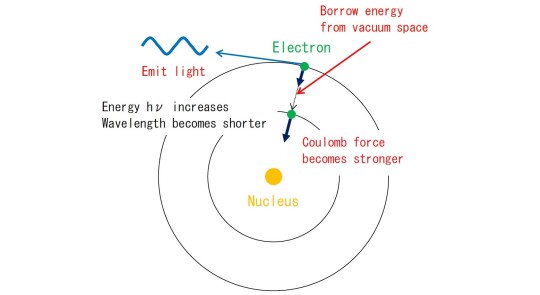
The order in which electrons fill the shells and subshells follows the design of the Creator. This order made transition elements that acted as catalysts for various chemical reactions in the early stages of biological evolution.

#science#physics#universe#creation of the universe#atom#nucleus#orbital electron#electron degeneracy pressure#atomic electron transition#electron shell#vacuum energy#dark energy#11 dimensions
0 notes
Text
ODIN: I've worked out what she's doing, and I'm going to attempt to provide a simplified explanation.
SWITCH: No. No more redactions. No more dumbing it down. No more deciding what we get to know. Tell it to us straight, dad.
ODIN (rolling his eyes): Ah, well, in that case. She’s attempting to artificially induce a supernova by siphoning matter from the core of Calliope's star, such that electron degeneracy pressure is reduced to the point it can no longer prevent a gravitational collapse. She hopes to create a Reissner-Nordstrom black hole with an accessible Cauchy horizon. She intends to cross that horizon, leaving her as an entity that possesses no past and infinite futures. She will be non-deterministic - previous energy states and subatomic interactions will no longer determine energy states and subatomic interactions in the future.
SWITCH: ...
ODIN: Are we feeling sufficiently unredacted?
57 notes
·
View notes
Text
compiling a list of math/physics-y concepts to be used as writing prompts
type 1a supernovae and type 1a supernovae revision - white dwarf stars pulling material from a red giant, eventualy accumulating enough material for explosions on the surface of the white dwarf to be observable; vs two white dwarf stars orbiting each other and eventually colliding and exploding, annihilating both while the explosion is observable - about the relationship (not any specific flavor of relationship) and how others perceive them vs how they perceive themselves and events that happen
parallel lines never intersect except like on the space of the surface of a sphere parallel lines don’t exist because all lines cross twice” - it’s about how in one life two people never cross paths/don’t work out or maintain a relationship but the fic is about the potential that they had if the universe had been slightly different
eigenvalues, eigenvectors: when a matrix acts on one of its eigenvectors, it returns the exact same vector without any rotation/transformation, except a scalar transformation - character study about events/things/people/whatever that dont change the essence of a person/trajectory theyre on, but do change something about... hm, about the magnitude of their personality? (this ones a bit of a.... stretch? (ba dum tsss))
kepler’s 2nd law: an object in orbit moves faster the closer it is to the center of orbit, and slower the farther away it is from the center of its orbit - idk yet
electron degeneracy pressure and the Pauli exclusion principle: when electrons are pushed together such that the distances between them are sufficiently small, the electrons cant exist in the same quantum state and thus a pressure is created which acts opposite to the gravitational force collapsing a white dwarf - something about stressful conditions and many characters getting shoved together and their differences somehow working to maintain something working even against external forces
quantum tunneling: if a particle with some energy is trapped in some potential well with infinite potential at walls, the particle can’t escape, that is to say, there’s 0 chance the particle will be found outside that potential trap. however, if the particle with some energy is trapped in a potential well, where the potential barriers aren’t infinite, there’s a chance that the particle can be found outside the potential trap even if its energy is smaller than that of the potential walls - uhh something about characters in bad situations and getting out of them even when classically they shouldn’t be able to get out at all
wip
#w101#wizard101#wiz101#wizzy101#wizard101 prompt#sols lore#okay look#i keep thinking about how stem-y concepts can be turned into writing prompts okay??#m
6 notes
·
View notes
Text
I worked too long on this not to show so
✨stellar evolution time✨
Low-mass stars: Red dwarfs of 0.1 SM will not expand as the whole star is a convection zone and it can not develop a degenerate helium core or hydrogen burning shell. Hydrogen fusion will continue until almost the entire star is helium. Slightly larger ones, however, do expand into red giants. Their helium cores aren’t big enough to reach the temp needed for helium fusion, so they never reach the tip of the red giant branch. When the hydrogen burning shell is exhausted, they move directly off the RGB like AGB stars do but at a lower luminosity to become white dwarfs.
Mid-sized stars*: A star w/ an initial mass of 0.6 SM can reach temps high enough for helium fusion. Stars roughly 0.6-10 SM become red giants. They are red giants at two points in their stellar evolution: RGB (inert cores of He and H burning shells) and AGB (inert carbon cores w/ He shells inside H shells). Between RGB and AGB stars are one the Horizontal branch (helium fusing cores), with stars tending towards the cooler end being called ‘red clump’ stars.
*After Sun-like stars (0.6-10 SM) finish fusing H into He, the core is primarily He and they keep fusing H in a spherical shell around the core. This process causes the star to expand through a subgiant phase to red giant. Stars with at least 1/2 SM can start fusing the He at their core, while bigger stars can fuse heavier elements in concentric shells around the core. One a Sun-like star has exhausted its fuel, the core collapses into a white dwarf and the outer layers are expelled in a planetary nebula.
•Subgiant - H is burned in a shell around the helium core, leading to the core becoming more massive. This continues for several million to 1 or 2 billion years depending on the mass of the helium core. The star expands and cools at a similar or slightly lower luminosity as its main sequence phase. Eventually either the core becomes degenerate (Sun-like stars) or the outer layers cool enough to become opaque (bigger stars). Either of these changes leads to an increase in luminosity and temp of the H shell, leading to the star expanding onto the RGB.
•Red giant - The expanding outer layers are convective, mixing material and bringing stuff up to the surface. Most of the material was inside the star prior to this, but the changes are usually unobservable. The effects of the CNO cycle appear during the first dredge up. The star is no longer in thermal equilibrium, either degenerate or above Schonberg-Chandrashekhar limit (max of how much envelope a non-fusing isothermal core can support), so it causes an increase in fusion in the H shell. The star’s luminosity goes up at the tip of the red giant branch.
•Horizontal branch - In the cores of 0.6-2 SM the He cores are supported by electron degeneracy pressure, He fusion will ignite in a helium flash. In bigger stars with a non-degenerate core, the ignition of He fusion is slow with no flash. The expansion of the core causes the H fusion in overlying layers to slow and energy production to decrease. The star contracts and thus moves to the horizontal branch. Stars tending towards the cooler end being called ‘red clump’ stars.
•Asymptotic giant - These stars have faster energy generation that lasts for a shorter time, paralleling the red giant evolution. Though helium is being burnt, most of the energy is from hydrogen shells farther from the core. The He created from the H shells periodically drops to the core and energy output from the He shell increases dramatically creating a thermal pulse. A deep convective zone happens causing a second dredge-up happens, bringing up carbon from the core. This causes a carbon star to be formed (very cool and strongly reddened stars w/ strong carbon emission lines). A process known as hot bottom burning may convert carbon to oxygen and nitrogen before it’s dredged-up, determining the observed luminosities and spectra in some clusters.
#astronomy#stellar evolution#stars#space#it wasn't as bad as I expected tbh#just a lot to remember lmao#I hope the formatting is okay
28 notes
·
View notes
Photo

Scientists discover pre-low-mass white dwarf binary A binary system containing an extremely low-mass (ELM) white dwarf (WD) progenitor and a compact invisible companion, was discovered by Chinese astronomers from the National Astronomical Observatories of Chinese Academy of Sciences (NAOC), using spectroscopic data from LAMOST and P200/DBSP, and multi-band photometric data from Catalina and Zwicky Transient Facility. The mass of the visible star, a pre-ELM WD, is about 0.09 solar masses, lower than the theoretical limit of its species, and may challenge the current formation theory of the ELM WD. The study has been published in The Astronomical Journal. Most stars in the universe will end their lives as white dwarfs after their nuclear fuel were burned out. Most of the white dwarfs are carbon-oxygen white dwarfs (CO WD), which means they are mostly composed of Carbon and Oxygen. They have masses of 0.5-1.4 solar masses. When the mass is greater than 1.4 solar masses, the electron degeneracy pressure at the core cannot resist the gravity and the white dwarf will continue to collapse into a neutron star. White dwarfs between 0.33 and 0.5 solar masses can have cores dominated by either CO or Helium (He). White dwarfs with even lower masses, known as ELM WDs, are composed of degenerate He. It is believed that these ELM WDs cannot form via the single star evolution channel, since the formation of such single low mass He WDs requires a progenitor star with a correspondingly very low initial mass and an extremely long evolution time, a time even longer than the current age of our universe. Therefore, it is generally accepted that ELMs are formed within interacting binary systems. In particular, it is proposed that the even lower mass fraction of ELMs (below 0.18 solar masses) loses most of its initial mass via a stable Roche Lobe overflow channel. To successfully form an ELM, the onset of the mass transfer should be at the right time. If the mass transfer starts too early, the donor will evolve into a low-mass main sequence star, similar to the secondary in the Cataclysmic Variable. On the other hand, if it starts too late, the core of the donor will be massive enough to evolve to the next stage by helium flash. Thus, there is a theoretical lower mass limit of the ELM-WD in such a restricted mass transfer process, which is about 0.14-0.16 solar masses. "The special pre-ELM-WD looks like a normal F-type dwarf star orbiting an invisible component every 5.27 hours. It may have just completed its mass-transfer phase and is moving slowly towards the white dwarf cooling path. Its constant luminosity implies that its energy is supplied by a tiny burning hydrogen shell outside the degenerate He core. However, its dynamical mass is only about 0.09 solar masses, below the lower limit of theoretical predictions, which is indeed puzzling," said Dr. Yuan Hailong, first author of the study. The mass of the system is estimated based on multi-band time-domain photometric and spectroscopic data and Gaia parallax. After taking into account all error budgets, the estimated mass is still significantly low. The team has tested several theoretical models, none of which could fit the results properly. This discovery raises a question about the current ELM formation mechanism that is still awaiting an answer. The invisible compact component could have a mass of ~1.0M☉, and is more likely to be a WD, but a neutron star cannot be ruled out at present. The ELM binary systems with compact companions may be continuous gravitational wave sources and are among the most revealing objects in the gravitational wave detection project. As an important progress of the LAMOST compact object search project, the discovery proves the ability of LAMOST to study the ELMs. With more time-domain plates coming in during LAMOST's second regular five-year survey, more interesting compact binary systems are expected to be discovered.
7 notes
·
View notes
Text
HOW DO STARS DIE AND HOW LONG DO STARS LIVE??
Blog#38 Saturday, November 21st, 2020
Welcome back,
A star’s life expectancy depends on its mass. Generally, the more massive the star, the faster it burns up its fuel supply, and the shorter its life. The most massive stars can burn out and explode in a supernova after only a few million years of fusion. A star with a mass like the sun, on the other hand, can continue fusing hydrogen for about 10 billion years. And if the star is very small, with a mass only a tenth that of the sun, it can keep fusing hydrogen for up to a trillion years, longer than the current age of the universe.

As stars get smaller, they live longer. Our own sun has been around for 4.3 billion years, slowly turning hydrogen into helium at its core. The sun will run out of this hydrogen fuel in another 5 billion year or so, and it will turn into a red giant. It will expand to many times its original size and then eject its outer layers and shrink down to a tiny white dwarf star, a dense object the size of the Earth. So the total lifespan of a star with the mass of the Sun is about 10 billion years.
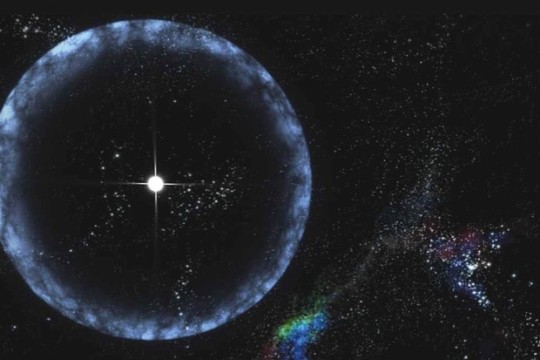
The smallest stars are the red dwarfs, these start at 50% the mass of the Sun, and can be as small as 7.5% the mass of the Sun. A red dwarf with only 10% the mass of the Sun will emit 1/10,000th the amount of energy given off by the Sun. Furthermore, red dwarfs lack radiative zones around their cores. Instead, the convective zone of the star comes right down to the core. This means that the core of the star is continuously mixed up, and the helium ash is carried away to prevent it from building up. Red dwarf stars use up all their hydrogen, not just the stuff in the core. It’s believed that the smaller red dwarf stars will live for 10 trillion years or more.

How long do stars last? The biggest stars last only millions, the medium-sized stars last billions, and the smallest stars can last trillions of years.
Answering the question, "How do stars die?" also depends on its mass. The most massive stars quickly exhaust their fuel supply and explode in core-collapse supernovae, some of the most energetic explosions in the universe. A supernova’s radiation can easily (if only briefly) outshine the rest of its host galaxy.

The remnant stellar core will form a neutron star or a black hole, depending on how much mass remains. If the core contains between 1.44 and 3 solar masses, that mass will crush into a volume just 10 to 15 miles wide before a quantum mechanical effect known as neutron degeneracy pressure prevents total collapse. The exact upper limit on a neutron star mass isn’t known, but around 3 solar masses, not even neutron degeneracy pressure can combat gravity’s inward crush, and the core collapses to form a black hole.

Average stars with up to 1.44 solar masses, such as the Sun, face only a slightly less exotic fate. As they run out of hydrogen to fuse in their cores, they swell into red giant stars before shedding their outer layers. The remnant left behind in these planetary nebulae is a white dwarf star. Like neutron stars, white dwarfs no longer fuse hydrogen into helium, instead depending on degeneracy pressure for support — this time, the electrons are degenerate, packed together and forced into higher energy states, rather than the neutrons.
COMING UP!!
(Wednesday, November 25th,2020)
“Astronomers Detect Millions of Signals From an Intelligent Civilization: Us”
#astronomy#astrophysics#astro notes#astrophotography#astronomylover#nightsky#white universe#universe#alternate universe#galaxies#gamma rays#stars#beautiful earth#moon#mars#the sun#sunspots#science#solar radius#solar panel#solar system#solar energy#solar power#milkway#space#outer space#spacecraft
70 notes
·
View notes
Note
i’m pretty sure the f*gofthewest2 person (who made or at least posted the ‘cia wants to steal my penis - don’t fall for this’ image) is some sort of alt right weirdo (that url NINE back up blogs the tag ‘#degeneracy’ in bio etc)
Thank you for letting me know!! I’ve deleted the post! Also I didn’t know that “degeneracy” was an alt right thing but I looked it up and it most definitely is, so I would like to apologize for when my url was “electron-degenerate” (it was that bc electron degeneracy pressure is something used in astrophysics to determine if a star is collapsing, and I was studying that and thought the phrase sounded cool at the time)
2 notes
·
View notes
Text
I’m not touching you!
Behold, Unus: a mutant that is just a slightly exaggerated version of every object in the known universe.

Okay, extremely exaggerated

That’s because, if you boil things down to ultimate technicalities, you can’t be touched by anyone else, either.
Although I suppose it depends on your definition of “touching”. I’m using the one that requires direct physical contact between matter bits. Which never actually happens.
You can never touch anything because the subatomic particles (specifically, the electrons) in all your atoms can’t ever actually come into direct contact with other electrons. On one hand, it’s because like-charged particles electrically repel one another. But on the other, quantum mechanics shenanigans cause electrons - while buzzing around in their atomic orbitals - to exert a pressure against one another that keeps them from getting too close.
You can try as hard as you want to push two atoms together, but physics ain’t gonna let you.
The only real-world situations when that happens is when star cores collapse. Stars like our Sun, which aren’t massive enough to go supernova, will shed their outer gas/plasma envelope and the core gravitationally pulls itself together. The only thing that ultimately stops that collapse is the electrons exerting a counter pressure. And you get a white dwarf.
(Stars that are more massive, meanwhile, will have their core remnant not be made of whole atoms, but neutrons. Neutrons have their own “degeneracy pressure”, and can pack way more closely than whole atoms can, so neutron stars can be a good 1000 times denser than white dwarfs - the densest matter in the universe, save black holes. But even then, they’re technically not touching one another.)
But before I go further off on a space tangent, there is one error that this X-Men issue makes...at least if we commit to this line of physics to discuss Unus’s powers. Mr. Untouchable can also not be touched by light.
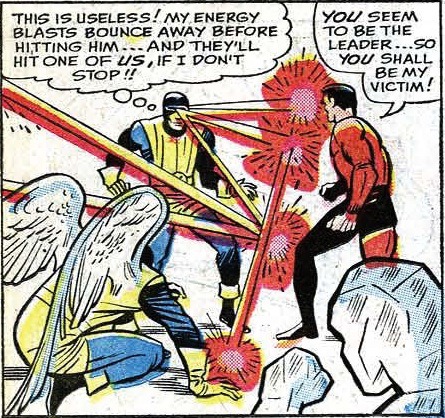
This would require a separate superpower, one that involves electromagnetic manipulation. Indeed, such a power would also explain why nothing else touches him (Again, ‘cause everything’s got electrons).
Including - after Beast shoots him with a power-booster ray gun - cake.
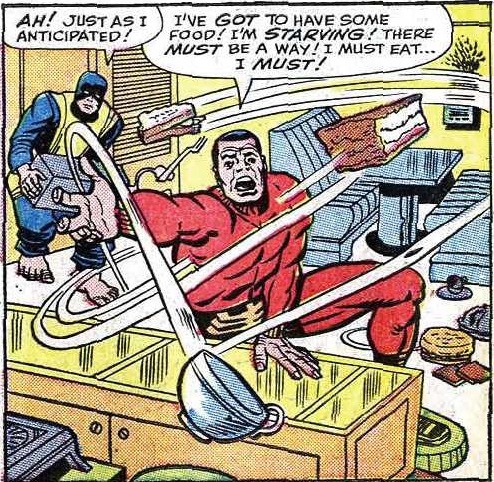
102 notes
·
View notes
Photo
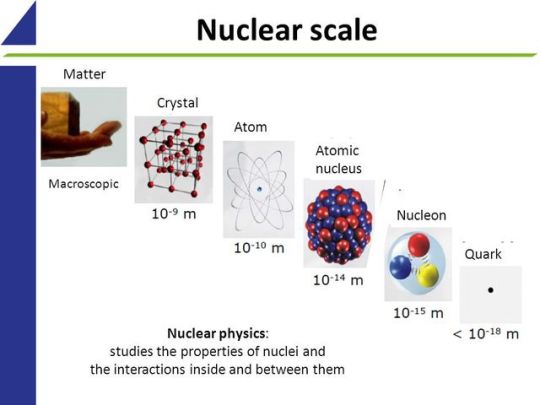









This Little-Known Quantum Rule Makes Our Existence Possible
“If we didn't have the Pauli Exclusion Principle to prevent multiple fermions from having the same quantum state, our Universe would be extremely different. Every atom would have almost identical properties to hydrogen, making the possible structures we could form extremely simplistic. White dwarf stars and neutron stars, held up in our Universe by the degeneracy pressure provided by the Pauli Exclusion Principle, would collapse into black holes. And, most horrifically, carbon-based organic compounds — the building blocks of all life as we know it — would be an impossibility for us.
The Pauli Exclusion Principle isn't the first thing we think of when we think of the quantum rules that govern reality, but it should be. Without quantum uncertainty or wave-particle duality, our Universe would be different, but life could still exist. Without Pauli's vital rule, however, hydrogen-like bonds would be as complex as it could get.”
When you think of quantum mechanics, you probably think of all the usual suspects. Wave/particle duality. The double slit experiment. Photons and electrons interfering with themselves. Schrodinger’s cat. The inherent uncertainty, due to Heisenberg’s principle, of knowing two physical quantities (like position and momentum or energy and time) simultaneously. But it’s the Pauli exclusion principle that tops them all in terms of giving us the chemical-rich Universe we have today. The elements are all different from one another, and Pauli’s exclusion rule explains why.
Come get the story behind the underappreciated quantum rule that makes our existence possible!
205 notes
·
View notes